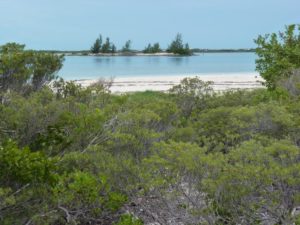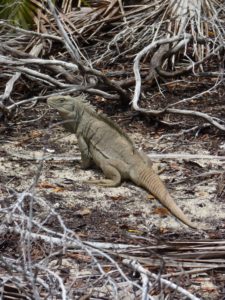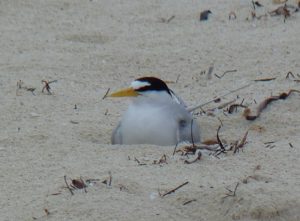23rd June 2016
Securing pockets of paradise in the Turks and Caicos Islands

Elizabeth Radford, Senior UK Overseas Territories Officer with the Royal Society of the Protection of Birds, talks about her recent visit to the Turks and Caicos Islands where RSPB is working with local partners on site conservation.
It was an overcast day in May when I climbed into a little motor boat and bounced across the insanely blue water from Providenciales to Little Water Cay – known locally as ‘Iguana Island’. Iguana Island is one of TCI’s premier nature attractions for visitors and a global biodiversity hotspot. It is managed by the National Trust of TCI, thus I was accompanied by the Trust’s Director Ms Gibbs-Williams and two of the island’s wardens, Elliott and Caldrin.
On arrival at the dock it’s quickly apparent why the island is so special; within seconds (literally) we spotted the stately Rock Iguanas (Cyclura carinata) basking in the sun in the gaps in dense native vegetation and even on the boardwalk. Rock Iguanas eat fruits of native vegetation (such as sea grape) and are critically threatened by rats and feral cats which eat their eggs and attack young. They are only found in TCI and one island in the Bahamas. RSPB is helping the National Trust undertake a programme of rat control to help safeguard the iguanas which began last November, as we walked around the island the Wardens were able to show me evidence of increasing numbers of small iguanas and two species of birds nesting on the ground where they had not seen this before on the island; a young Antillean Nighthawk and several Least Terns on the adjacent beach known as Half Moon Bay. These new sightings suggest the rat control is working and the iguanas (and birds) are recovering. The Wardens are ready to undertake more rat control with RSPB later this year and ongoing management will ensure rat populations don’t get out of control again. The problem of feral cats remains, they are an even greater threat to the iguanas than rats, and the next challenge to tackle to secure the iguana’s future.
A few days later I took the ferry to North Caicos and met Mrs Alveria Duncombe (TCI National Trust) and B. Naqqi Manco (DECR), who would guide me around another site managed by the National Trust, known as Wade’s Green Plantation. Wade’s Green is the Caribbean’s best surviving Loyalist Plantation (1798-1812), and also home to TCI’s finest example of dry tropical forest. I had missed the Plantation on a previous trip to North Caicos so was full of anticipation as we walked up the original ‘Kings Road’ bordered by 200 year old dry stone walls leading to the heart of the old settlement. I was not disappointed.
Immediately we glimpsed shy Key West Quail Doves and heard calls of two rarer Caribbean birds: a Pearly-eyed Thrasher and a Thick-billed Vireo. The torrential tropical downpour added to the atmosphere as we explored the various plantation buildings, some now fused together with trees. Mrs Alveria and Naqqi provided fascinating historical facts about each building and insights into the lives of those who lived on the plantation. The heritage and nature fascinated me in equal measure, from ship graffiti drawn by the slaves on the kitchen wall, to the tiny creamy egg we found in the wall of the old storehouse belonging to the Caicos Barking Gecko which now makes its home in the nooks and crannies of this building. Most of all I enjoyed exploring the roads beyond the main settlement, including the well at the crossroads and the old slave quarters hidden deep within what I was now calling ‘the enchanted forest’.
The RSPB will be helping the Trust manage and improve this wonderful site in the coming year, with the aim of both safeguarding the site and fulfilling its potential as a premier visitor attraction for TCI.
At the end of the week a more intrepid adventure was in store. Long time RSPB supporters Nick and Sarah Sherwin invited me on a trip to TCI’s last wilderness; the uninhabited remote island of East Caicos. The mosaics of terrestrial and mixed habitats there are the best examples in the Caribbean and are home to many special plant and animal species. At least six species are found only in TCI and over 20 species found only in the ‘Lucayan Peninsula’ – meaning the Bahamas and TCI together.
Mark Parrish and Kathleen Wood (experts on the geography and biodiversity of East Caicos) were our guides on this trip, and my adrenalin was certainly high as we waded ashore through the gloopy estuarine mud and sand. We had already spotted a green turtle and a large stingray in the reef and some agitated Royal terns met our arrival onshore. This is no easy relaxed Caribbean island, a quick change to cover up against the hungry mosquitoes and we started off through the buttonwood and mangroves to the dense native bush, at times using a machete to open up the route. We walked the line of the old railway carefully avoiding the needle like Sisal spikes and poisonous Manchineel trees. The railway was built in the late 1800s to allow the removal of bat guano harvested from the caves for fertiliser, as well as the Sisal plants introduced and grown for fibre for ropes and twine. Both were short lived industries.
Finally we reached the extensive cave systems where we were shown extraordinary petroglyphs; 500 year old carvings on the cave walls made by Taino Indians. As we moved through the darkness a barn owl silently swooped through the cave above our heads, a magnificent moment.
Later as we returned to Providenciales by boat we were joined fleetingly by a pod of leaping spotted dolphins – a fitting end to the day. It occurred to me that each time I visit TCI I lift another layer on the natural beauty of this Territory. The tropical paradise of sandy beaches and turquoise seas lauded in the holiday brochures is only the shiny surface, beneath lies a natural and cultural heritage that is a great deal more intriguing, beautiful and unique than this simple picture. Those in TCI who are charged with the task of sustaining and protecting this heritage face a difficult and enormous task, one that deserves all our support as it is immensely important, not only for TCI but for the planet too.



Little Water Cay Rock Iguana Least Tern
Great Blog Really